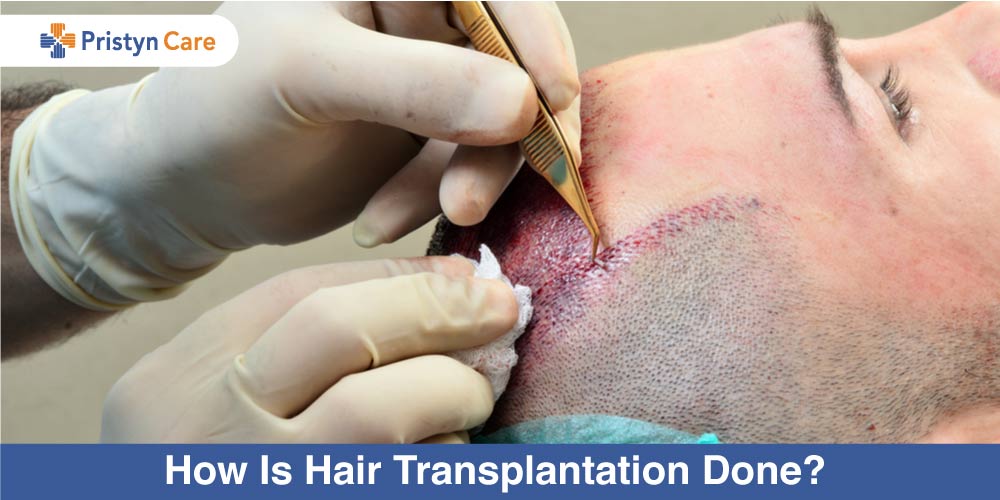
Hair plays an important role in enhancing a person’s look, personality and confidence. Most of us tend to take the health of our hair for granted until it’s totally gone. If hair thinning or baldness is causing you emotional trouble, you will be pleased to know that we have the most reliable treatment available for you now. Yes, it is hair transplantation! A simple, safe and medically recommended solution that can make a lot of difference to your whole personality and also boost your attitude.
Table of Contents
What is hair transplantation?
Hair transplantation is the surgical procedure of filling the area of your head which has very thin hair or no hair at all. The process is primarily performed to treat male-pattern baldness.
Hair transplantation is done by taking hair from other parts of the body or thicker parts of the scalp, and then grafting or implanting it in the balding or thinning scalp.
How is the hair transplant done?
Hair transplant is a daycare procedure. You can return home the same day after the surgery is over.
In simple words, the doctor takes hair follicles from part fo the scalp where hair is present (also known as donor area) and implants these follicles into the area where there is baldness (also known as recipient area). The entire procedure is performed under the influence of anesthesia which means that the person is unable to feel anything other than a prick on the scalp.
The surgery is usually done in a doctor’s clinic. There are two methods of doing a hair transplant – Follicular Unit Strip Surgery (FUSS) or Follicular Unit Extraction (FUE). Let’s understand both these processes in detail now.
Follicular Unit Strip Surgery (FUSS)
This process is also known as Follicular Unit Transplantation (FUT). Here is a step-by-step procedure-
- To perform the procedure, the surgeon will first numb the back of the head with local anesthesia.
- The surgeon will also sterilize the area from where the hair will be taken. Using a scalpel, he will remove a section of your scalp, generally from the back of your head.
- With stitches, the surgeon will then close the area from where the scalp has been removed.
- The surgeon and his team then separates the scalp and divides it into tiny pieces using a scalpel. The scalp may be split in to as many as 2,000 small pieces which are known as grafts.
- With the help of a needle, the surgeon makes small holes in the rest of the scalp where the hair will be transplanted.
- The surgeon then inserts the small grafts into the holes. This process is known as grafting.
- With the help of bandages, the surgeon then closes the surgical site.
Follicular Unit Extraction (FUE)
Here is a detail explanation of what a Follicular Unit Extraction procedure entails-
- In this process, the surgeon will first shave the back of your head. Using local anesthesia, he will numb the back of the head.
- He will then remove individual hair follicles from the shaved part. This is known as extraction
- The surgeon will then make small holes in the rest of the scalp and graft the hair follicles.
- The surgical site will then be covered with a bandage.
Direct Hair Implantation (DHI)
At Pristyn Care, doctors use this latest technique for hair implantation. There are several advantages of using this technique over FUE and FUT. Here is a step-by-step procedure of the DHI technique-
- First, the doctor trims hair in the donor area, especially at the back of the head.
- The doctor injects local anesthesia to numb the scalp so that there is no pain.
- Using a special pen-like instrument known as DHI implanter, the doctor removes hair follicles from the donor area without touching other hair.
- Then these follicles are processed into grafts in a laboratory.
- After this, the doctor again implants these processed follicles in the received area.
- These follicles can be implanted in a way such that the direction of the hair can also be decided.
Number of Grafts Required for Hair Transplantation
The number of grafts required for hair transplantation may vary from person to person. It primarily depends on:
- Size of the transplanted area
- Hair quality
- Hair color
- Type of hair you have
Also Read: How to get the best results after hair transplantation?
Aftercare Tips For Hair Transplantation
It is crucial for patient to take care of the hair once the hair transplantation is complete. This reduces chances of any side effects and complications during the recovery. Here are some tips that you need to consider after a hair transplant:
- Use only mild shampoo to wash your hair for a few weeks after the surgery.
- Don’t brush or comb the new grafts. Be very gentle with it.
- Don’t wear hats, caps, helmets until the doctor allows.
- Refrain from doing any strenuous work for a few days after the surgery.
- Wait for a few months to get your haircut.
Also Read: Do’s and Don’ts After Hair Transplantation
What To Expect After Hair Transplant?
It is common for people to experience some mild side effects after hair transplantation. Here’s what you can expect in the initial days of the recovery.
- Itching- Like any other surgical site, your scalp might start itching after the hair transplant surgery. However, you should be careful that you do not scratch your scalp, doing so might lead to infection in the scalp.
- Bleeding- Bleeding is the most common side effect of a hair transplant surgery. You should be gentle with the scalp and try to keep it clean as far as possible.
- Infection – There are chances that your hair follicle might lead to some infection which is known as folliculitis. These kinds of infections are generally not severe and can be treated with gel, ointment or medicated cream.
Find the best surgeons for hair transplant at Pristyn Care
Hair transplant is a very intricate process. It requires both excellence and expertise. At Pristyn Care, we take pride in the quality of hair transplantation procedures that we provide and professionalism that our surgeons exhibit. Pristyn Care has some of the most experienced and sought after surgeons, which means you can put extreme trust in us with the process of your hair transplantation.
Also Read:







